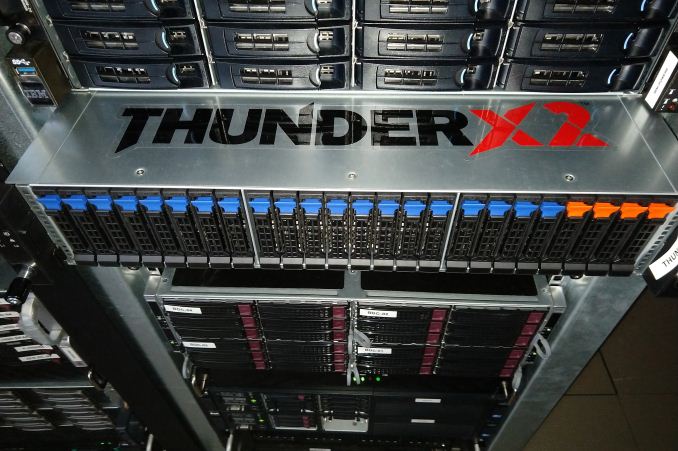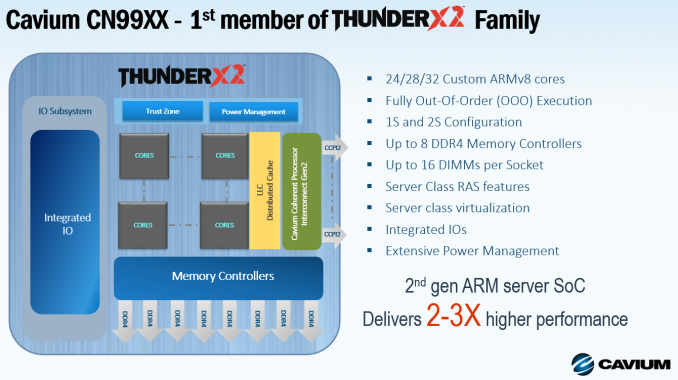Assessing Cavium's ThunderX2: The Arm Server Dream Realized At Last
by Johan De Gelas on May 23, 2018 9:00 AM EST- Posted in
- CPUs
- Arm
- Enterprise
- SoCs
- Enterprise CPUs
- ARMv8
- Cavium
- ThunderX
- ThunderX2

A little less than 2 years ago, we investigated the first Arm server SoC that had a chance to compete with midrange Xeon E5s: the Cavium ThunderX. The SoC showed promise, however the low single-threaded performance and some power management issues relegated the 48-core SoC to more niche markets such as CDN and Web caching. In the end, Cavium's first server SoC was not a real threat to Intel's Xeon.
But Cavium did not give up, and rightfully so: the server market is more attractive than ever. Intel's datacenter group is good for about 20 Billion USD (!) in revenue per year. And even better, profit margins are in 50% range. When you want to profits and cash flow, the server market far outpaces any other hardware market. So following the launch of the ThunderX, Cavium promised to bring out a second iteration: better power management, better single thread performance and even more cores (54).
The trick, of course, is actually getting to a point where you can take on the well-oiled machine that is Intel. Arm, Calxeda, Broadcom, AppliedMicro and many others have made many bold promises over the past 5 years that have never materialized, so there is a great deal of skepticism – and rightfully so – towards new Arm Server SoCs.
However, the new creation of underdog Cavium deserves the benefit of the doubt. Much has changed – much more than the name alone lets on – as Cavium has bought the "Vulcan" design from Avago. Vulcan is a rather ambitious CPU design which was originally designed by the Arm server SoC team of Broadcom, and as a result has a much different heritage than the original ThunderX. At the same time however, based on its experience from the ThunderX, Cavium was able to take what they've learned thus far and have introduced some microarchitectural improvements to the Vulcan design to improve its performance and power.
As a result, ThunderX2 is a much more "brainiac" core than the previous generation. While the ThunderX core had a very short pipeline and could hardly sustain 2 instructions per clock, the Vulcan core was designed to fetch 8 and execute up to 4 instructions per clock. It gets better: 4 simultaneous threads can be active (SMT4), ensuring that the wide back-end is busy most of the time. 32 of those cores at clockspeeds up to 2.5 GHz find a home in the new ThunderX2 SoC.
With up to 128 threads running and no less than eight DDR4 controllers, this CPU should be able to perform well in all server situations. In other words, while the ThunderX (1) was relegated to niche roles, the ThunderX2 is the first Arm server CPU that has a chance to break the server market open.











97 Comments
View All Comments
DrizztVD - Wednesday, May 23, 2018 - link
It amazes me how the one big advantage ARM could have is the power efficiency, yet no power efficiency numbers in this review? It's like someone just isn't thinking about what can best showcase the ARM advantage and testing it.boeush - Thursday, May 24, 2018 - link
You must have missed this bit:"So as is typically the case for early test systems, we are not able to do any accurate power comparisons.
In fact, Cavium claims that the actual systems from HP, Gigabyte and others will be far more power efficient."
This was an early (and apparently quite buggy, especially from the power management standpoint) test system. It's not representative of final production systems in these respects, so doing what you request on it would only put a very crude lower bound on efficiency, at best.
That's why the final section of the write-up has a title ending in ": so far"... (obviously, there will be more to come if/when real production-quality systems are available for benchmarking/analysis.)
ZolaIII - Thursday, May 24, 2018 - link
It's broken currently on the MB. If you want to see real power/performance metrics for a SoC made on comparable lithography to the lintels 14 nm (aka TSMC 10nm) & with optimised software read this:https://blog.cloudflare.com/neon-is-the-new-black/
drwho9437 - Wednesday, May 23, 2018 - link
Thanks Johan, I've been reading since Ace's. I can't believe it has been more almost 20 years. Even though I don't work in this market I still read everything you write.JohanAnandtech - Friday, May 25, 2018 - link
It was indeed almost 20 years ago that I published my first article about the K6-2 vs Pentium MMX. And Anand's star was about to rise with the launch of the K6-3 :-).Spatz - Wednesday, May 30, 2018 - link
Wow. Aces hardware... that used to be my go to for hardware reviews back in the day. I can’t believe your still at it! This article was great. Keep up the good work.beginner99 - Thursday, May 24, 2018 - link
So it for sure is an option. however I d not get the focus on price. The CPU cost is a small fraction of the total server cost and a tiny if infrastructure cost (network, HVAC,...) is included. Add to that the software and data running on that server and if your CPU is 5% faster at same power it costing $5000 more might be totally worth it.Apple Worshipper - Thursday, May 24, 2018 - link
Errmm... does ARM feature SMT now?Ryan Smith - Thursday, May 24, 2018 - link
Not in Arm's own cores. But in Cavium's ThunderX2, yes.sgeocla - Thursday, May 24, 2018 - link
What's up with EPYC comparison missing in almost all benchmarks?EPYC has been out for a while and the only benchmarks are from almost a year ago?